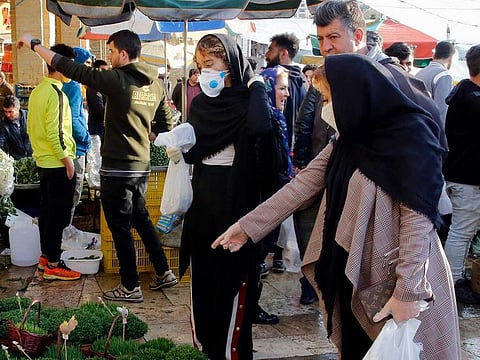Iran, Trotsky and the coronavirus outbreak
Countries which invested in people seem to fare better in the fight against the virus

Stuck at home on the weekend, like most people these days, I watched ‘Doctor Zhivago’, David Lean’s 1965 classic, starring Omar Sharif: a story of doomed love in a world gone mad.
It seemed somehow appropriate, and I am not talking only about its three-hour running time.
Acclaimed Soviet writer Boris Pasternak’s epic novel, set in the first two decades of the last century, got me thinking of the lines drawn today among different worlds and systems by the coronavirus pandemic.
Russia in those years was going through multiple challenges. The Bolshevik revolution, the civil war, the First World War and the attempt of the Communist Party, under Vladimir Lenin and Leonid Trotsky, to establish a viable state on the ruins of the old Tsarist regime.
World at war against an invisible enemy
As I watched the movie, the coronavirus news updates kept interrupting me; all of a sudden, the tragic situation in Iran seemed so familiar and could have been easily what Pasternak was describing in his book. A country that has yet to move from revolution to a state.
The world is at war, literally, and the enemy is so powerful it cannot be fought with military arsenals, conventional or otherwise. The coronavirus is an invisible enemy. And it has forced the lockdown of developed countries, shattered mighty economies and deconstructed most globalisation trends in a matter of weeks.
Those who invested in the development of the wellbeing of their people will for sure come out of this crisis faster and with the least cost than others. On the other hand, those who invested their countries resources in futile military programmes, developing unconventional weapons and feeding dated ideologies are struggling today to contain the outbreak and keep their population safe.
How UAE leads the way
Let’s take the case of a small country like the UAE. This nation has managed to contain the risk of the virus from day one and extended its hand to help other countries. The UAE today has one of the least number of cases in the region. It has successfully evacuated thousands of foreigners stranded in China and Iran to safety. Food and medicine stocks are amply available and there’s no panic on the streets, as we see in numerous countries. World Health Organisation (WHO) statements cite the UAE as a successful example in dealing with the pandemic. This is a result of years of sound planning that focused on ensuring the wellbeing and prosperity of citizens and residents at all times.
Then there is Iran. There are about 18,000 confirmed infections and nearly 1,200 deaths. It is the third worst-infected nation, after China and Italy. And it was supposed to be that way. Health experts blame the government for its delayed response and its attempt to cover up the real figures which led to the disease spreading faster. Until today, the regime refuses to acknowledge its failure in dealing with the crisis.
President Hassan Rouhani on Thursday claimed that Iran’s response was more efficient than that of western countries. “You can compare Iran to other countries ... Compare Tehran to London, Berlin, and Paris,” he said. On the same day, 17 doctors, including five former health ministers, sent him a letter warning that the situation in Iran was very dangerous and it will get worse if his government doesn’t take the necessary measures to contain the virus.
Iran went on to waste its vast wealth on nurturing its revolutionary plans rather than invest in developing a state system for the wellbeing of its people. Its policies led to conflicts with the international community.Mohammed Almezel, Editor at Large, Gulf News
The doctors may be asking too much. Fighting a powerful enemy such as the COVID-19 requires an integrated system of a functioning state. The failure of Iran to deal with the outbreak shows that such a system perhaps doesn’t exist. The Iranian ruling elite still thinks their nation is in a state of ‘permanent revolution’ that could even be exported to other states in the region.
Trotsky came up with the term permanent revolution, where the country, Russia in his case, would be in constant revolution until a ‘complete victory’ of the dictatorship of the proletariat, the working class, is realised. In Iran’s case, it would be the complete victory of the religious oligarchy. Trotsky’s theory holds that his permanent revolution is not a national system. It must be a world system. The Russian revolution, to be successful, similar revolutions must succeed in other countries.
Where Iran failed
Similarly, Iran’s permanent revolution was never meant to be a national one. Tehran has been trying to export its failed ideology to the region. They spent billions of dollars to plant and nurture political and military influence in places like Lebanon, Iraq and Yemen.
Therefore, Iran went on to waste its vast wealth on nurturing its revolutionary plans rather than invest in developing a state system for the wellbeing of its people. Its policies led to conflicts with the international community. Iran can blame the American sanctions for its failure to deal with the outbreak. But the sanctions are the result of decades of antagonistic policies by the Iranian regime.
I am not sure how Iran will fare in its fight against the coronavirus. We all hope and pray they succeed.
But this battle should serve as a turning point, a lesson to the ruling elite to stop their belligerent regional policies and focus on rebuilding their country. Otherwise, Iran’s future will be just like that awful scene in Doctor Zhivago where hundreds of shivering and starving people on a train that seems to travel forever.
Also Read: Is the coronavirus media’s Frankenstein?
Also Read: Loneliness in the time of the coronavirus
Sign up for the Daily Briefing
Get the latest news and updates straight to your inbox



